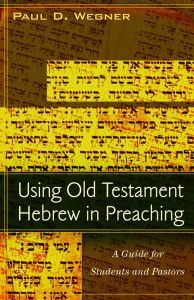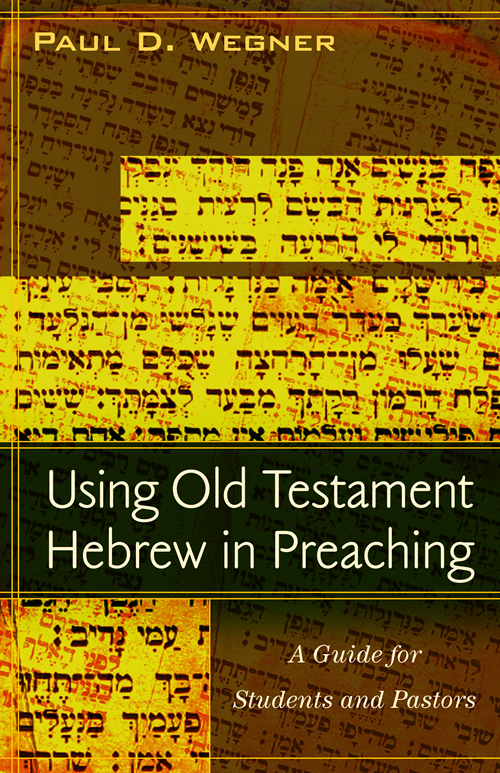Wegner, Paul D. Using Old Testament Hebrew in Preaching: A Guide for Students and Pastors. Grand Rapids, MI: Kregel Academic, 2009, pp. 176, $19.99 paperback.
In Using Old Testament Hebrew in Preaching, Paul D. Wegner provides current and former students of biblical Hebrew with the necessary tools and ample encouragement to maintain and use their knowledge of biblical Hebrew. Wegner currently serves as the Distinguished Professor of Old Testament Studies at Gateway Seminary in Ontario, CA. He is also the author of other works that may be familiar to many seminary students: The Journey from Texts to Translations and A Student’s Guide to Textual Criticism of the Bible.
Wegner writes Using Old Testament Hebrew in Preaching with a certain audience in mind: seminary students who have taken at least one year of Hebrew and pastors who need encouragement to maintain their Hebrew knowledge (p. 8). Observing the lack of Hebrew resources—compared to the abundance of Greek resources—Wegner provides his readers with practical tools for using biblical Hebrew in sermon preparations (p. 8). In the first chapter, Wegner answers the question of how Hebrew is helpful in ministry. In the second chapter, he provides his readers with the “crucial tools” for maintaining biblical Hebrew and preparing sermons from the Old Testament. In the third chapter, Wegner defines exegesis and briefly explains how one exegetes a passage. In the fourth chapter, he offers practical advice on how to prepare a sermon from the Old Testament. In the fifth and final chapter, Wegner provides helpful tips on how to maintain one’s Hebrew vocabulary and translation skills and how to use Hebrew in sermon preparation. Wegner completes his work with five appendices containing worksheets for sermon preparation, an extensive list of scholarly and lay commentaries for Old Testament study, and a syntactical analysis of the Hebrew text of Psalm 23.
There is much to commend in Wegner’s work. Wegner writes with a light style and does not burden his readers with drawn out explanations. He clearly defines his terms and methods and judiciously inserts charts and lists within the body of the text. For example, in his discussion on Bible software, Wegner provides charts with detailing the features and costs of various software packages, allowing the reader to compare the available programs. Throughout the book, Wegner follows his discussions with lists of helpful resources. For example, in his discussion on beginning Hebrew grammars, Wegner sprinkles various grammars throughout the section and then follows the discussion with a more extensive list (pp. 42-44). With easy access to lists of resources, Wegner saves his readers from having to flip to an appendix or to the end of chapters to find a resource.
Wegner strikes an encouraging tone in Using Old Testament Hebrew in Preaching. Interspersed among the chapters are quotes by and bios of great men and scholars of the Christian faith. The quotes and bios highlight the importance of various elements of sermon preparation such as Hebrew and Greek, prayer, and the use of commentaries. The most encouraging aspect of Wegner’s work is that Wegner makes the goal of maintaining and using biblical Hebrew attainable. Wegner suggests that readers consult the guidelines set by the Foreign Service Institute of the United States Department of State to determine the preferred reading level of biblical Hebrew. The levels range from R-1—an elementary level in which the reader can work through easier passages and yet heavily relies on other resources—to R-4—full proficiency (pp. 21-22). The reading levels provide the biblical Hebrew student with a realistic expectation of the work involved for the chosen level and communicate to the student that full proficiency is not required to use biblical Hebrew in sermon preparation. Furthermore, Wegner’s suggestions on maintaining Hebrew vocabulary and translation skills are practical and not overbearing.
As with any reference list, readers may or may not find Wegner’s suggestions helpful. However, Wegner generally keeps to resources that have proven valuable over time. Also, in his discussion on the literary analysis of various passages Wegner suggests source criticism, form criticism, and redaction criticism are useful tools to examine a specific text (pp. 72-76). Again, readers may or may not find these suggestions helpful depending on their view of various critical methods.
A seminary student, minister, or lay leader in a church who desires to continue to work on their biblical Hebrew will find Wegner’s Using Old Testament Hebrew in Preaching a valuable resource. The book will give the reader an excellent place to start reviewing lost Hebrew vocabulary or to use Hebrew in a sermon. However, Wegner notes that the decision to continue to study biblical Hebrew is ultimately up to the reader (p. 121).
Richard C. McDonald
The Southern Baptist Theological Seminary





